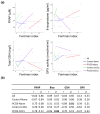Oxidative Stress in Polycystic Ovary Syndrome: Impact of Combined Oral Contraceptives
- PMID: 39456422
- PMCID: PMC11505064
- DOI: 10.3390/antiox13101168
Oxidative Stress in Polycystic Ovary Syndrome: Impact of Combined Oral Contraceptives
Abstract
Polycystic Ovary Syndrome (PCOS) is a complex hormonal disorder that is associated with heightened metabolic risks. While oxidative stress (OS) is known to play a role in PCOS, the precise nature of the relationship between PCOS and increased OS remains not entirely understood. Combined oral contraceptives (COCs) are the first-line treatment to regulate menstrual cycles and androgen levels, but their impact on oxidative stress requires further study. We conducted a transcriptomic analysis using RNAseq and assessed the levels of various oxidative stress (OS) markers in serum samples from women with PCOS and controls and whether they were using combined oral contraceptives (COCs), including enzymatic activities, FRAP, and 8-isoprostane (8-iso). A total of 359 genes were differentially expressed in women with PCOS compared to control women. Genes differentially expressed were enriched in functions related to inflammation and, interestingly, oxidative stress response. In controls, 8-iso levels were increased in women using COCs, whereas in women with PCOS, 8-iso levels were reduced in those using oral contraceptives (191.1 ± 97 vs. 26.4 ± 21 pg/mL, p: <0.0001). Correlation analyses showed a trend for a negative correlation between 8-iso and Ferriman score in women with PCOS consuming COCs (r = -0.86, p = 0.06) and a negative correlation between GSH and hyperandrogenism in women with PCOS (r = -0.89, p = 0.01). These results reveal the presence of lipid peroxidation in women with PCOS, which was modified by the use of COCs, providing new insights into the pathophysiology of PCOS in the Chilean population.
Keywords: cardiovascular risk; contraception; hormones; metabolism.
Conflict of interest statement
The authors declare no conflicts of interest.
Figures





Similar articles
-
Metabolic and cardiovascular impact of oral contraceptives in polycystic ovary syndrome.Int J Clin Pract. 2009 Jan;63(1):160-9. doi: 10.1111/j.1742-1241.2008.01877.x. Epub 2008 Sep 13. Int J Clin Pract. 2009. PMID: 18795969 Review.
-
Risks, benefits size and clinical implications of combined oral contraceptive use in women with polycystic ovary syndrome.Reprod Biol Endocrinol. 2017 Dec 8;15(1):93. doi: 10.1186/s12958-017-0313-y. Reprod Biol Endocrinol. 2017. PMID: 29216881 Free PMC article. Review.
-
Effects of long-term administration of an oral contraceptive containing ethinylestradiol and cyproterone acetate on lipid metabolism in women with polycystic ovary syndrome.Acta Obstet Gynecol Scand. 1995 Jan;74(1):56-60. doi: 10.3109/00016349509009945. Acta Obstet Gynecol Scand. 1995. PMID: 7856434 Clinical Trial.
-
AMERICAN ASSOCIATION OF CLINICAL ENDOCRINOLOGISTS, AMERICAN COLLEGE OF ENDOCRINOLOGY, AND ANDROGEN EXCESS AND PCOS SOCIETY DISEASE STATE CLINICAL REVIEW: GUIDE TO THE BEST PRACTICES IN THE EVALUATION AND TREATMENT OF POLYCYSTIC OVARY SYNDROME--PART 1.Endocr Pract. 2015 Nov;21(11):1291-300. doi: 10.4158/EP15748.DSC. Endocr Pract. 2015. PMID: 26509855
-
Comparison of Drospirenone- with Cyproterone Acetate-Containing Oral Contraceptives, Combined with Metformin and Lifestyle Modifications in Women with Polycystic Ovary Syndrome and Metabolic Disorders: A Prospective Randomized Control Trial.Chin Med J (Engl). 2016 Apr 20;129(8):883-90. doi: 10.4103/0366-6999.179783. Chin Med J (Engl). 2016. PMID: 27064030 Free PMC article. Clinical Trial.
References
Grants and funding
LinkOut - more resources
Full Text Sources
Molecular Biology Databases
Miscellaneous

